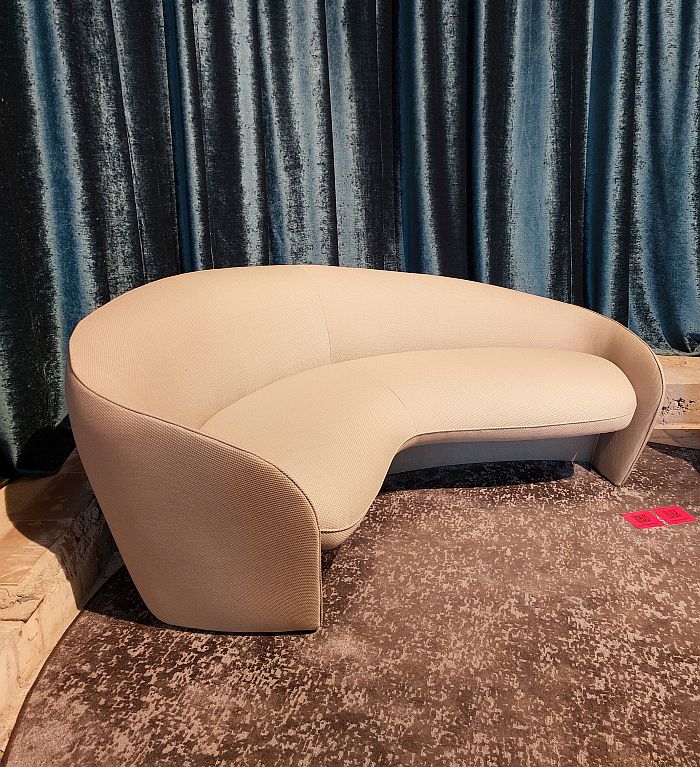
The publicity for 360 Design, the central showcase of Budapest Design Week 2024, that Hungarian Fashion and Design Agency, HFDA, showcase that was a component of Budapest Design Week before the HFDA took over the organisation of Budapest Design Week and it exponentially increased in stature, involved numerous objects by Budapest based designer Hevesi Annabella1, not least the sofa Dedas, a work we're most partial to, we'll never forget our disbelieving joy when it popped-up unexpectedly at Berlin Design Week 2024. How we stood in the corridor in the Peter-Behrens-Bau staring trying, failing, trying again, to compute what our eyes were telling us. But that said, if we'd been exposed to Dedas at 360 Design, we would have screamed.
Fortuitously for us, and for all at 360 Design when we visited, Dedas wasn't there, or at least not physically, but Annabella was represented with the new Pulse sofa and Pulse armchair for her own label Self and Scope.
A Pulse sofa on which one could sit. A Pulse armchair on which one couldn't. Thus we'll mainly concern ourselves here with the sofa.
A Pulse sofa that as we sat on it, in it, our thoughts continually drifted to the 1956 Tete-a-Tete sofa by Edward J Wormley, not formally, Wormley's is rigidly quadratic while Annabella's is a free-flowing curve, is essentially a kidney sofa, nor in terms of the communication the form enables, empowers, with others, with Pulse the free-flowing curve makes it a lot more personal than Tete-a-Tete, but rather in the way that both could be pigeonholed as Art Deco or Art Nouveau.
Which is so wrong. And so unfair. And so problematic. Pigeonholing tending as it does to reduce objects of daily use down to a visual, blinds to the whys, whats and wherefores of an object, is ignorant of, has no interest in, the processes by which the object arose, was developed and came to be. Alone serves the ends of marketing, publishing and social media.
And an ease of pigeonholing of Pulse, and of Tete-a-Tete, reinforced later on when we read the 360 Design curatorial statement, a text which sought to place contemporary design in Hungary in context of design in Hungary in a previous epoch, did that thing of trying to claim the existence of a t**** in contemporary design, something we're obviously going to disagree with, and which sought objects to confirm the validity of that claim, something, again, we're obviously going to disagree with; and a 360 Design curatorial statement which opined that "the rich artistic and craft traditions of the Secession and Art Deco are revived in the work of today's designers".
We do hope not.
We hope the spirit is.
We hope the motivations and inspirations of Secession and Art Deco are studied and placed in context.
We hope the lessons of Secession and Art Deco are approached in an open and honest fashion.
We hope Secession and Art Deco are critically questioned, challenged, forced to defend themselves.
We hope Secession and Art Deco are appreciated as being beyond art an craft and as being responses to prevailing realities.
We hope Secession and Art Deco provide instructive input to enable "today's designers" to approach today's problems.
But a revival? Really?
And do we want that?
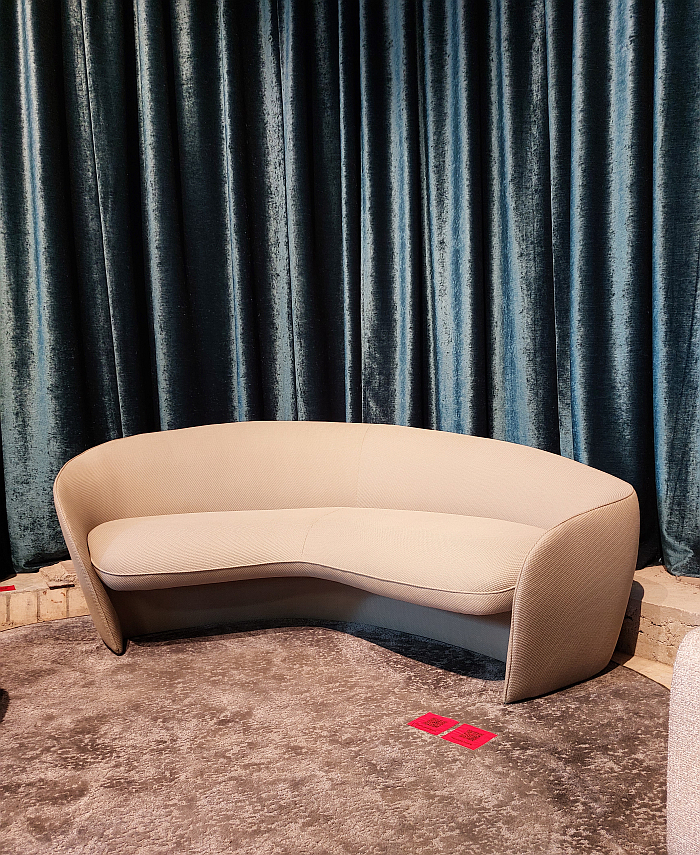
The subject is admittedly particularly present in our brains at the moment having watched the film E.1027 – Eileen Gray and the House by the Sea about 17 times in quick succession, and the thoughts therein stimulated on Eileen Gray's relationship to Art Nouveau: much of her furniture work can, without question, be traced back to Art Nouveau, but is also an uncompromising break with, a challenge to, a rejection of, the positions and motivations of the period.
And that is what we need now. Not a hankering after a past that is instructive, informative, relevant but is the past. It was a century ago, Hungary is different, Europe is different, Hungary's place in Europe is different. We can't stay the same. Our objects of daily use can't stay the same.
We noted something similar in context of the exhibition Kaesz Homes 1925-1960. The homes of designer couple Kaesz Gyula and Lukáts Kató at Walter Rózsi Villa, Budapest, and in context of Polc íróasztallal by Woodoo at Otthon Design Budapest 2024, a work that has definitely studied Szecesszió, but is definitely a 21st century work.
In context of Woodoo we also noted that Mid-century modern is gone, but remains relevant and important in informing contemporary design. Similarly the Hungarian positions from the second half of the 20th century, be it the continuations of Functionalist Modernism, challenges to Functionalist Modernism or the first steps with fledgling digital technology, are long gone but very relevant and important when approaching contemporary Hungary.
For us it is always a problem when particular epochs are held up as being definitive for design (and architecture) in any region; the (hi)story of design (and architecture) in any region is the dialogue over the decades between varying positions and the dialogue over the decades between our objects of daily use and social, economic, political, technical, ecological et al realities. An ongoing dialogue to which the past needs must be present, but not directly. An ongoing dialogue that must always be undertaken in the present tense.
The (hi)story of design in Hungary can't be pigeonholed as Szecesszió; rather, it's everything that was in context of everything that is with an eye on what could, should, must be.
You can't hanker after the past, you must always live in the now. Informed by the past.
Which we'll argue is what Edward J Wormley did. And is what we'll argue Hevesi Annabella does. Albeit Annabella isn't as restricted in her definition of 'past'.
The tulip and folkloric in, for example, the Vanishing Cabinet, the architecturally skeuomorphic housing anchors of the Middle Ages as the basis for Peach, the 1970s Hungarian enamel art in the Roly-poly lamps, and, yes, in Dedas, that 21st century ode to the (hi)story of enamelling in Hungary as both a banal utilitarian and a rousing decorative process that contribute in equal measure to the functioning and enjoyment of daily life. As does Dedas.
And a past re-found in the now that is also the Pulse sofa. To bring us, finally, back to the subject at hand.
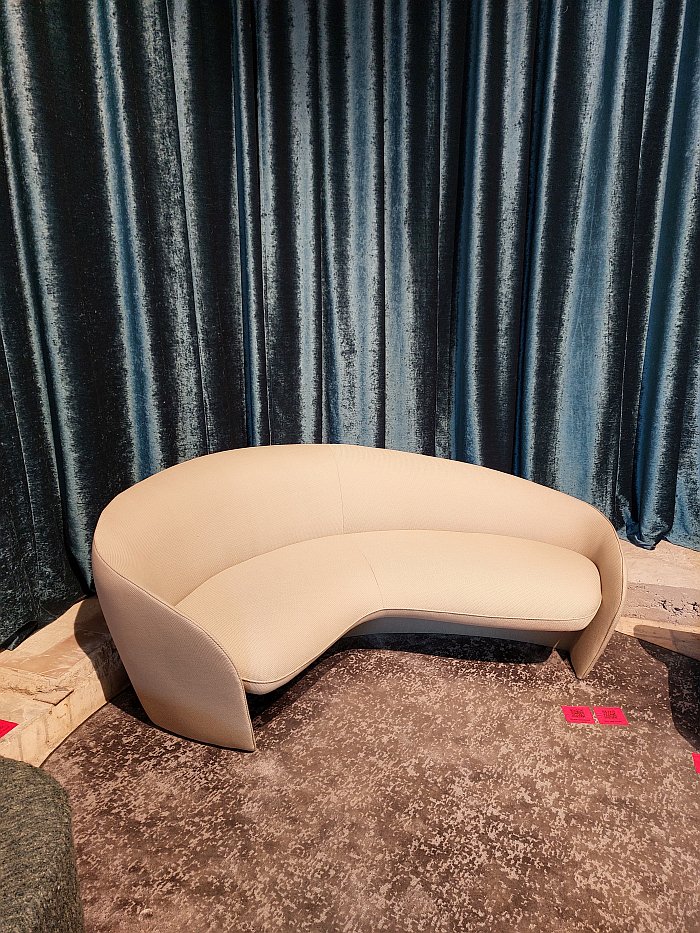
An object that, if we're correctly informed, but as ever we may not be, began in a commission in context of an architecture project related to music, which took the initial ideas for its potential form from that music, from the visual language of music, making it a very neat example of Annabella's approach, and developed that into an object that plays with the dimensionless of space, a dimensionless most sofas, including Tete-a-Tete, seek to force, coerce, into the 3D dimensions of human perception, but which Pulse approaches as freely as music does, uses all the space available to it, tangibly and intangibly, without dominating or making other uncourtly demands on the space, and that not least because it is not only as dimensionless as music but a dimensionless that is also a weightlessness, certainly a visual weightlessness: the sweeping side/backrest and (apparently) suspended seat have a transience, a delicacy. If an implied transience and delicacy, we suspect, not reflected in a physical weightlessness: we didn't try lifting it, but, we suspect, it is a sturdy object, which isn't a criticism, just an observation, a suspicion.
A sweeping side/backrest that also mean it is a sofa with(out) armrests, they are simultaneously present and absent; and an (apparently) suspended seat, it isn't, is securely attached to the frame, that provides for a high degree of seating comfort, whether with or without the aid of the side/backrest backrest whose presence, when permanent, is unevenly shared along the length of the sweeping curve: is more backrest at one end and armrest at the other. A neat transition.
And while, yes, as noted above, the form that Pulse, the Pulse sofa, has taken on is without question that of ye olde kidney shaped sofa that was a feature of Art Nouveau, and of Mid-century Modernism, it's a kidney shaped sofa that, as with all children of the now, is a bit embarrassed by its older relatives. Older relatives whose raison d'etre was more often that not opulence and vanity, were little more than extended chaise longues who existed to frame the sitter when visitors were there; Pulse is a (dimensionless) space to share with others, a (dimensionless) space that brings sitters into communion with one another, that encourages and empowers an intimacy other kidney shapes sofas in their self-obsession shy away from. A difference of character very much indicative of the changes in society and of personal relationships over the past century and a bit, of a de-formalising of personal relationships and social conventions over the past century and a bit.
But a (dimensionless) space which if you should find yourself alone in offers a variety of seating experiences at the various points along its journey; offers a variety of modes of use, you could possibly curl up in it like a cat, we didn't try, but we heard the invitation. Is a sofa that actively invites you to explore it and get to know it through experience, that doesn't dictate or expect as furniture once did, and often still does.
An open communicative character, and dimensionless and weightlessness, that arise from its genesis rather than a formalistic desire to recreate that bequeaths Pulse a quiet, unassuming elegance and universality.
Whereby its possibly not a primary sofa for a family home, but is definitely a domestic sofa, and very much a sofa for public or commercial contexts.
But for all is a sofa for 21st century spaces.
No-one in early 20th century Budapest would understand Pulse, it would make absolutely no sense to them. Which is fine, it's not for them. Design must always be directed to the now.
And so, yes, you can call it Szecesszió, its not, it's definately not, but you can if you want to: but in doing so you're denying yourself not only the greater part of the fun of the work, nor only the access Pulse offers to Hevesi Annabella, but denying yourself a meaningful relationship with the work. Which would be a shame.
As noted there is also an armchair that very much follows the sofas lead, but which we could only look at. So we'll skip over here.
Further details on Pulse, Hevesi Annabella and Self and Scope can be found at www.selfandscope.io
And for all in or near Budapest, the Pulse sofa and armchair, and all other selected works, can be viewed and enjoyed at 360 Design, Nyugati Railway Station, 1062 Budapest, Teréz krt. 55 until Sunday October 20th.
Full details can be found at https://360dbp.com
And full details on Budapest Design Week 2024 can be found at https://hfda.hu
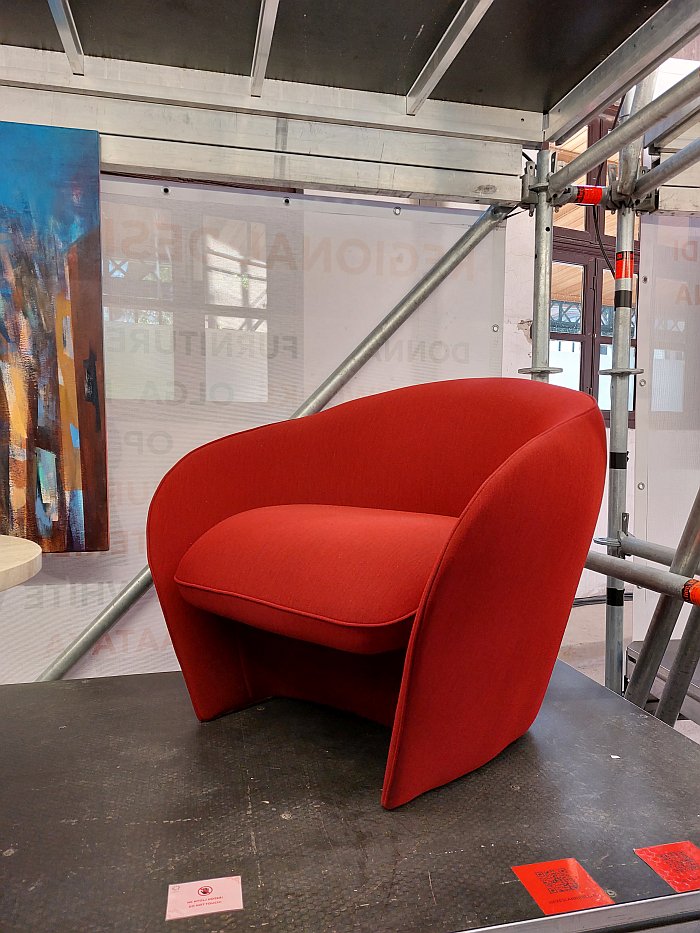
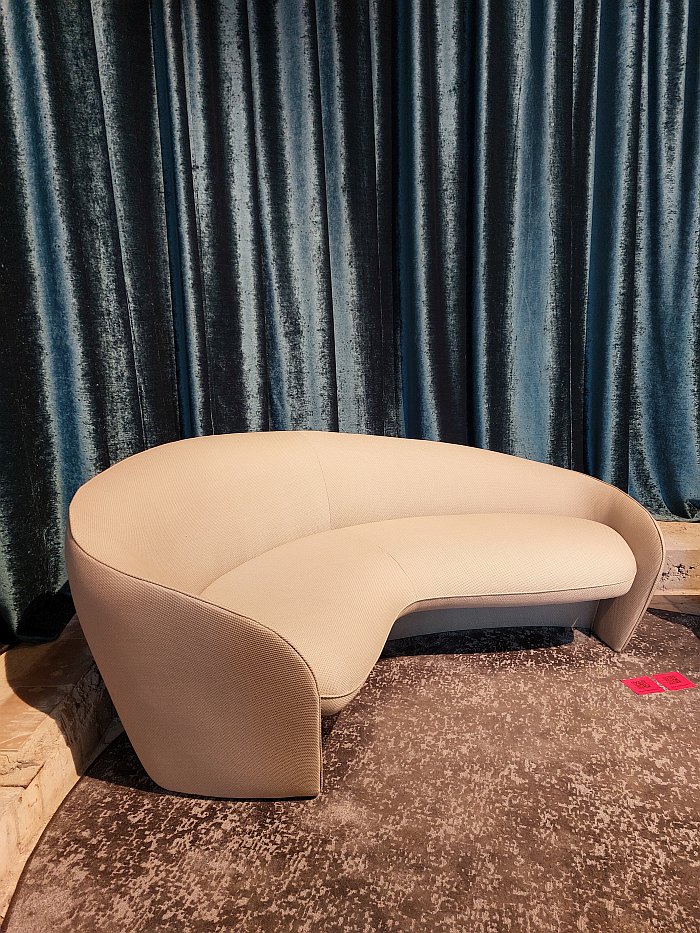
1Until now we've always referred to Annabella Hevesi in these dispatches, we have however made an editorial decision to use conventional Hungarian notation when discussing Hungarians... seems polite...thus its now Hevesi Annabella